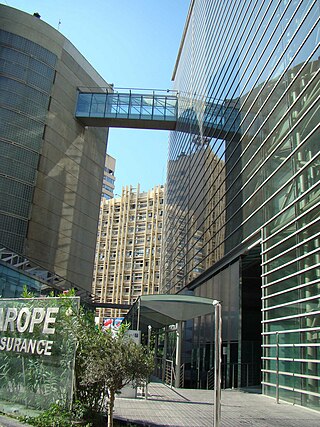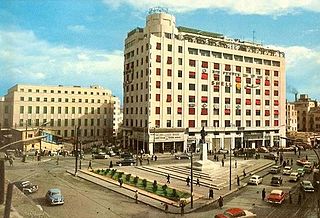
The Holiday Inn Beirut is a ruined hotel in Beirut, Lebanon on Omar Daouk Street in the central Minet el Hosn neighborhood. The Holiday Inn was in operation for less than a year before the Lebanese Civil War broke out in 1975. [1]

The Holiday Inn Beirut is a ruined hotel in Beirut, Lebanon on Omar Daouk Street in the central Minet el Hosn neighborhood. The Holiday Inn was in operation for less than a year before the Lebanese Civil War broke out in 1975. [1]
The hotel was constructed between 1971 and 1974 by Lebanese developer Abdal Mohsin Kattan [2] and designed by French architect André Wogenscky, working with Lebanese architect Maurice Hindié. [3] The 26-storey hotel included a revolving restaurant on the top floor, a nightclub on the 25th floor, and 400 guest rooms. [4] It was part of a mixed-use complex known as St. Charles City Center, including a cinema, offices, shops, restaurants, a supermarket. It was constructed on the site of the Hospital St Charles, which had been founded by the German religious order of Saint Charles Borromeo in 1908, but had moved to Baabda, north of Beirut, in 1963. [5] The Holiday Inn opened in 1974, at the height of Beirut's economic boom, when the city was the glamorous tourist center of the Middle East.
The Holiday Inn operated normally for only a year before the Lebanese Civil War broke out in 1975. The hotel was a war zone beginning on 25 October 1975 [4] in a months-long conflict known as the Battle of the Hotels, as over 25,000 combatants from pro-Palestinian and Christian militias fought for control of a group of towering luxury hotels including the Holiday Inn and the adjacent Phoenicia Inter-Continental, resulting in over 1,000 deaths (many of those who died were thrown from the top of the Holiday Inn) [2] and 2,000 injuries. [6] The hotel was seen as a heavily symbolic goal by both sides in the conflict, and fighting for it was fierce, finally ending on 21 March 1976. [7]

After the battle, the ruined hotel was stripped to its concrete skeleton by scavengers. [6] It became a battleground again during the 1982 Lebanon War between Al-Mourabitoun and Amal fighters. Since then, the hotel has remained a gutted, bullet-riddled ruin, looming over the city. The ownership of the structure is split. The Lebanese company that owns half of it, Compagnie Immobiliere Libanaise, wants to renovate it and convert it to condos, while the Kuwaiti group that owns the other half wants to demolish it and construct a new tower on the site. [6] As a result of the disagreement, it remains empty and untouched, decades after the war and its brief year of operation; due to its strategic location in Beirut's city centre, the ruined hotel and its immediate surrounding ground level areas were declared a military zone under the control of the Lebanese Army, which currently restricts access to civilians.

Beirut is the capital and largest city of Lebanon. As of 2014, Greater Beirut has a population of 2.5 million, which makes it the third-largest city in the Levant region and the thirteenth-largest in the Arab world. The city is situated on a peninsula at the midpoint of Lebanon's Mediterranean coast. Beirut has been inhabited for more than 5,000 years, making it one of the oldest cities in the world.

Achrafieh is an upper-class area in eastern Beirut, Lebanon. In strictly administrative terms, the name refers to a sector (secteur) centred on Sassine Square, the highest point in the city, as well as a broader quarter (quartier). In popular parlance, however, Achrafieh refers to the whole hill that rises above Gemmayze in the north and extends to Badaro in the south, and includes the Rmeil quarter.

The Lebanese Forces is a Lebanese Christian-based political party and former militia during the Lebanese Civil War. It currently holds 19 of the 128 seats in Lebanon's parliament and is therefore the largest party in parliament.

Martyrs' Square, historically known as "Al Burj" or "Place des Cannons", is the historical central public square of Beirut, Lebanon.

The Beirut Central District is the historical and geographical core of Beirut, the capital of Lebanon. Also called downtown Beirut, it has been described as the “vibrant financial, commercial, and administrative hub of the country.” It is thousands of years old, with a traditional focus of business, finance, culture, and leisure.
Joseph Philippe Karam (1923–1976) was a Lebanese architect. He was a leading figure of modern architecture in Lebanon during the country's golden era, 1945 to 1975. Karam founded his practice the Atelier d'Architecture Joseph Philippe Karam in the late 1940s.

The Corniche Beirut is a seaside promenade in the Central District of Beirut, Lebanon. Lined with palm trees, the waterfront esplanade has views of the Mediterranean and the summits of Mount Lebanon to the east. Corniche Beirut has its foundation in the Avenue des Français, which was built during the period of the Mandate for Syria and the Lebanon along the seafront that extended from the old town.

Rue Verdun, or Verdun Street, is an upscale commercial and residential street in Beirut, Lebanon. The street, which is a major shopping center and tourist attraction, was named in honor of the Battle of Verdun during World War I. It is officially named Rachid Karami Street, after Lebanon's late Prime Minister who was assassinated during the Lebanese Civil War.

Platinum Tower is a highrise residential building in Beirut, Lebanon. It occupies a large plot on the Zaitunay Bay Marina, at Saint George Bay in the Beirut Central District.
The InterContinental Phoenicia Beirut is a historic 5-star luxury hotel situated in the Minet El Hosn neighborhood of Beirut, Lebanon. It is located on Rue Fakhreddine near the Corniche Beirut promenade and walking-distance from Beirut Central District, and a few kilometers from Beirut Rafic Hariri International Airport.
Jal El Dib or Jal Ed Dib is a Lebanese city in the kaza of Matn in the Mount Lebanon Governorate11 kilometers north of the capital city of Beirut.

Zahlé is a city in eastern Lebanon, and is the capital and the largest city of Beqaa Governorate, Lebanon. With around 150,000 inhabitants, it is the third-largest city in Lebanon after Beirut and Tripoli and the fourth-largest taking the whole urban area.

The Battle of the Hotels was a subconflict within the 1975–77 phase of the Lebanese Civil War that occurred in the Minet-el-Hosn hotel district of downtown Beirut. This area was one of the first major battles of the war that began in April 1975. The battle was fought for the possession of a small hotel complex, the St. Charles City Center, adjacent to the gilded Corniche seafront area on the Mediterranean, in the north-western corner of the downtown district of Beirut, and it quickly spread to other areas of central Beirut. The often fierce battles that ensued were fought with heavy exchanges of rocket and artillery fire from the various hotel rooftops and rooms. Sniper fire was commonly utilized.

The architecture of Lebanon embodies the historical, cultural and religious influences that have shaped Lebanon's built environment. It has been influenced by the Phoenicians, Romans, Byzantines, Umayyads, Crusaders, Mamluks, Ottomans and French. Additionally, Lebanon is home to many examples of modern and contemporary architecture. Architecturally notable structures in Lebanon include ancient thermae and temples, castles, churches, mosques, hotels, museums, government buildings, souks, residences and towers.
The following is a timeline of the history of the city of Beirut, Lebanon.

Beirut City Hall, also known as the Municipality of Beirut, is a landmark building built in downtown Beirut, Lebanon in 1924, and has become an architectural landmark in the downtown area of Beirut Central District. It features a yellow limestone facade and combines various architectural styles. The building is located on the intersection of Foch Street and Rue Weygand in the city center. The building is in the Venetian and Arabesque architectural styles, a mix that expresses the regional identity of the area. The building was restored after the Lebanese Civil War and it currently houses the office of the Governor of Beirut and the municipal council. It is open to the public and for official registration of documents.

The Hotel St. Georges is a historic resort hotel in Beirut, Lebanon, opened in 1934. It was constructed by a French investment group, the Société Des Grands Hotels Du Levant (SGHL), during the period of the French mandate. Parisian architect Auguste Perret came to Beirut to design the hotel with local architect Antun Tabet.

Riad Al Solh Square is a square in the heart of downtown Beirut, Lebanon.

The Egg, or the Dome, is an unfinished cinema building in Beirut, Lebanon. Its construction began in 1965 but was interrupted with the outbreak the Lebanese Civil War in 1975 and the horse-shoe shaped dome that remains today is now a landmark in Beirut. It was part of a commercial and residential project named "Beirut City Center", by architect Joseph Philippe Karam.
Le Commodore Hotel Beirut, also known as the Beirut Commodore Hotel, Hotel Commodore, or simply the Commodore is a five-star luxury hotel located on Rue Baalbek in the Hamra district of Beirut in Lebanon.